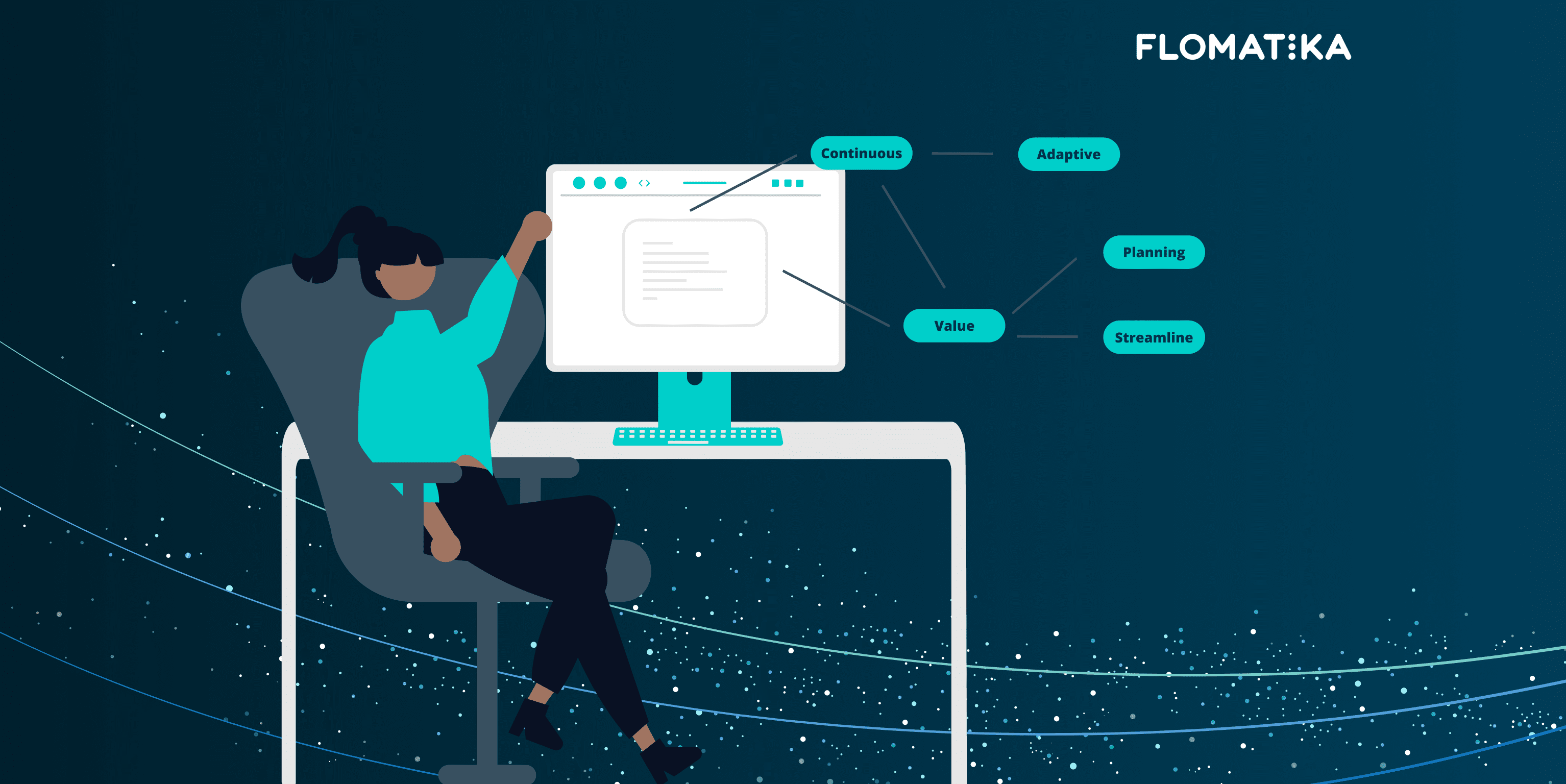Essential Strategies: A Guide to Lean Portfolio Management for Your Business

Are you ready to optimise your delivery ecosystem today?
book demoIn this article, we present a guide to Lean Portfolio Management which demystifies the method, offering a direct, step-by-step approach that promises strategic alignment and operational efficiency without the jargon. Expect to discover how LPM differs from traditional models and the practical steps you can take to implement these adaptive, value-driven practices.
Key Takeaways
- Lean Portfolio Management (LPM) integrates Lean-Agile principles with continuous, adaptive planning to optimise value delivery and align strategy with execution, distinguishing itself from traditional portfolio management.
- LPM relies on five key principles of Lean thinking which include identifying customer-centric value, streamlining value delivery, achieving continuous flow, establishing strategic themes and objectives, and navigating the investment life cycle with adaptive planning.
- Lean Portfolio Management tools are crucial for implementing LPM effectively, and organisations should select tools based on compatibility with their maturity, goals, and needs to enhance visibility, streamline processes, and maximise value.
Exploring the Core of Lean Portfolio Management
Lean Portfolio Management (LPM) is a methodology that harnesses Lean-Agile principles to structure Agile teams and Agile Release Trains (ARTs) based on value streams. The ultimate aim? To optimise the delivery of value while transitioning from yearly planning to a continuous, flow-oriented approach managed through a portfolio Kanban system. LPM aligns strategy and execution through continuous, adaptive planning. This approach is further supported by well-defined roadmaps.
So, what sets LPM apart from traditional portfolio management? Unlike the latter, LPM applies Lean principles throughout the portfolio’s life cycle, focusing on achieving strategic business outcomes. It involves:
- Defining, evaluating, and prioritising projects based on strategic alignment
- Improving portfolio flow
- Implementing LPM practices which can significantly enhance business outcomes, underpinning the philosophy of continuous and adaptive planning.
The Three Pillars of Lean Thinking in Portfolio Management
Lean thinking forms the bedrock of Lean Portfolio Management, paving the way for streamlined processes, reduced waste, and maximise customer value.
We will now examine the three critical principles of Lean thinking and their application to portfolio management.
Identifying Customer-Centric Value
In Lean Portfolio Management, value is viewed through the lens of the customer. It’s about aligning the portfolio with the customer’s needs, ensuring that the solutions developed are beneficial, thus optimising the overall value of the portfolio. To identify customer-centric value, organisations need a clear understanding of their customer requirements and a keen focus on specific user segments.
Nevertheless, organisations could face hurdles when identifying customer-centric value, including lack of leadership support, ambiguous vision, or organisational silos. Overcoming these obstacles requires fostering a customer-centric culture, aligning offerings with customer needs, breaking down silos, and empowering employees. Metrics also play a crucial role in this process, providing objective indicators of progress towards business agility and focusing on improving value delivery.
Streamlining Value Delivery
In LPM, value delivery optimisation requires thorough examination of the full value stream, ensuring it corresponds with the overarching business strategy. A cornerstone of this process is the elimination of waste, which involves prioritising value-driven activities and removing unnecessary processes. This approach also aids in establishing quality from the outset, minimising expensive corrections, and rework.
The objective of establishing a continuous flow of value is to ensure seamless progression of steps in the value stream, devoid of interruptions or bottlenecks. This enhances the efficiency and expediency of value delivery, contributing to the streamlining of value delivery in LPM.
Achieving Continuous Flow
In Lean Portfolio Management, sustaining a smooth, uninterrupted workflow is of paramount significance. It helps in minimising lead times and ensuring effective value delivery. Flow metrics, which measure the flow of business value across all the activities within a value stream, play a pivotal role in assessing whether our process is efficient and in good health.
Implementing a continuous flow in LPM requires understanding the total capacity for new development work compared to ongoing maintenance and support activities. This encompasses a continuous flow of Lean budgeting and planning, integrating new data, feedback, and information, and adjusting plans accordingly. However, bottlenecks may arise, such as software testing and quality review processes, which can impact the flow of work.
Setting the Stage: Establishing Strategic Themes and Objectives

Laying out a clear vision and strategic objectives is a basic characteristic of effective portfolio management; these elements guide decision-making and prioritise investments, setting the stage for successful portfolio management. A strategic portfolio review can further enhance this process by evaluating the current state of the portfolio and identifying areas for improvement.
Crafting a Vision for Your Portfolio
Crafting an attractive portfolio vision in sync with organisational goals is an essential initial move in lean portfolio management. A strong vision generates energy and enthusiasm, heightens commitment, facilitates change, and establishes a longer-term framework for near-term decisions. To align this vision with the organisation’s goals, it’s essential to evaluate the vision statement’s relevance regularly, ensuring its alignment with the organisation’s identity, trajectory, and ambitions.
Creating a compelling vision involves:
- Identifying important stakeholders
- Initiating with a list of keywords
- Addressing foundational questions
- Selecting a vision that is both exciting and aligned with your values
- Considering the positive impact the product can make
- Ensuring the vision statement is clear and succinct.
Aligning Investments with Business Strategy
Making sure that portfolio investments fall in line with the organisation’s strategic objectives is pivotal in maximising these investments’ impact. Organisations can achieve this alignment by conducting strategic alignment analysis and ensuring that projects are in line with the organisation’s long-term business goals, following a well-defined strategy and investment funding approach.
Navigating the Investment Life Cycle
Knowing how to give priority to high-value initiatives and modifying plans to suit dynamic market conditions is crucial for navigating the investment life cycle and securing investment funding.
Prioritising High-Value Initiatives
In portfolio management, giving importance to high-value initiatives is of crucial importance. This involves:
- Identifying high-value initiatives through value stream identification workshops
- Actively managing the investment backlog
- Establishing strategic themes with defined outcomes and metrics for performance measurement.
Prioritising these initiatives involves using techniques such as the Cost of Delay concept, Net Present Value, or the Eisenhower chart to objectively compare and rank projects.
Adaptive Planning for Dynamic Markets
In volatile markets, accepting continuous, adaptive planning is of utmost importance. This involves capturing and prioritising demand, planning and executing work, and integrating it into the overall portfolio strategy. Adaptive planning addresses the challenges posed by dynamic market conditions by empowering organisations to devise alternative plans and swiftly adjust to changes, incorporating dynamic forecasting capabilities to generate precise and adaptable forecasts that can respond to market shifts.
It sustains a competitive advantage in portfolio management through the promotion of a flexible structure, enabling the dispersal of decision rights, ensuring financial excellence, and fostering strategic agility. An effective enterprise strategy includes methods such as:
- Integrating dynamic asset allocation with advanced models and algorithms
- Ensuring transparency into work and constraints
- Prioritising based on customer expectations
- Employing adaptive resource management
- Establishing strategic themes and outcomes
- Funding and allocating by value stream
- Capturing and managing adaptive strategic planning.
Orchestrating Agile Portfolio Operations

In Lean Portfolio Management, Agile portfolio operations hold a significant role by orchestrating and backing decentralised Agile Release Train (ART) execution within the Scaled Agile Framework, thereby promoting operational excellence.
Empowering Teams for Agile Execution
Enabling teams for agile execution forms a crucial part of Lean Portfolio Management. It involves:
- Enabling teams to work autonomously and efficiently by providing the appropriate tools, resources, and support
- Coordinating and supporting decentralised Agile Release Train (ART) execution
- Collaborating across silos and organising around value
- Providing successful Agile Release Train (ART) execution patterns
- Implementing Lean budgeting mechanisms
- Coordinating portfolio governance
- Providing tools for the capture and management of workflow
To facilitate decentralised execution and decision-making within teams, organisations can allocate funds to team-of-teams through agile budgeting and delegate decision-making authority to establish a reliable system for leaders to delegate responsibilities.
Fostering Cross-Functional Collaboration
Interdepartmental collaboration is crucial for empowering Agile teams. It plays a key role in breaking down silos, enabling the organisation around value, and facilitating Agile budgeting and decentralised decision-making. However, organisations may encounter obstacles such as conflicting goals and priorities, inadequate communication, mistrust, and divergent technologies. To overcome these obstacles, promote transparent communication, harmonise goals and objectives, foster trust and team unity, offer proficient leadership and management, and tackle resource constraints.
An organisation can foster a culture of continuous improvement, innovation, and learning by promoting experimentation, embracing feedback, and creating opportunities for employees to enhance their skills and knowledge.
Embracing Lean Governance for Efficiency
Lean governance holds a significant position in Lean Portfolio Management, offering:
- Effective supervision of portfolios and projects
- Maintaining agility
- Enhancing transparency
- Data-driven insights
- A commitment to continuous improvement.
Implementing Lean Budgets and Guardrails
In Lean Portfolio Management, Lean budgeting is an essential element, offering a holistic approach that speeds up the delivery of products and solutions, boosts business outcomes, and aligns with corporate strategic objectives. By assigning budgets to value streams and establishing spending policies, guidelines, and practices for the portfolio, Lean budgeting facilitates value-driven spending, enabling each value stream to operate with flexibility, autonomy, and efficiency.
A critical aspect of this is the establishment of guardrails to prevent budget overruns, promoting quick decision-making and financial oversight.
Evaluating Portfolio Performance with Key Performance Indicators (KPIs)
In Lean Portfolio Management, Key Performance Indicators (KPIs) denote distinct and quantifiable gauges of business outcomes for the value streams within the portfolio. KPIs play a crucial role in assessing the effectiveness of project management offices (PMOs) and monitoring progress by serving as measurable indicators of business outcomes for the value streams within the portfolio. They can also be utilised to identify areas for improvement in portfolio management by offering a method to assess performance, aiding in the comprehension of an organisation’s strengths and weaknesses.
Moreover, KPIs play a critical role in facilitating the alignment of the portfolio with strategic objectives by enabling the assessment of projects according to their alignment with the organisation’s overarching strategic goals.
Maximising Value with Lean Portfolio Management Tools
Lean Portfolio Management tools not only bring a plethora of benefits such as streamlining processes, increasing visibility, boosting decision-making, and in the end, maximising value, but also help organisations implement lean portfolio management effectively.
Tool Selection Criteria
Selecting the appropriate Lean Portfolio Management tools is extremely important because they must align with the organisation’s maturity, goals, and specific needs to effectively ease portfolio management processes. Essential characteristics to seek in Lean Portfolio Management tools encompass the capability to visualise and limit work-in-process (WIP), support for strategic mapping, and integration with lean principles.
When comparing different Lean Portfolio Management tools, it is important to evaluate how they can facilitate the organisation’s portfolio management processes by taking into account the organisational maturity, strategic objectives, and specific needs.
Transforming Challenges into Opportunities
Though the implementation of Lean Portfolio Management can yield numerous benefits, it doesn’t come without challenges. Common obstacles include:
- Lack of clear strategic alignment
- Overloading resources
- Inadequate change management
- Ignoring metrics and reporting
- Lack of leadership support
- Ignoring feedback
- Resistance to change
- Failure to adapt
However, these challenges can be transformed into opportunities for success. Organisations need to maintain flexibility and adaptability, recognising that LPM is a continuous process. Not only this, but they must also be ready to continuously evolve and improve their methods to tackle emerging challenges and opportunities.
Enhancing Business Outcomes Through Lean Practices
Lean practices provide a strategic edge in boosting business outcomes. The primary lean practices that can be utilised to improve business outcomes include the implementation of the 5 principles of lean, adherence to a Lean process improvement methodology, and the adoption of a lean business management strategy.
Lean Portfolio Management principles enhance business performance by implementing lean portfolio management practices, such as:
- Establishing a common mindset to enhance operational efficiency
- Eliminating bottlenecks
- Increasing business agility
- Striking a balance between efficiency and flexibility
- Aligning the business with agile development principles
Recognising improvements is essential for strengthening a culture of continuous improvement and success, which is a fundamental element of Lean Portfolio Management.
Summary
Lean Portfolio Management offers a strategic approach to align business strategy, execution, and governance, driving business agility and improving performance. By adopting lean principles, organisations can streamline processes, eliminate waste, deliver value at scale, and ultimately enhance business outcomes. With the right tools, teams, and practices, Lean Portfolio Management can serve as a game-changer for businesses, enabling them to navigate the dynamic market landscape with agility and resilience.
Frequently Asked Questions
What is the lean portfolio management process?
The lean portfolio management process focuses on eliminating waste by prioritising work that adds the most value, ultimately connecting an organisation's strategy to its execution. This involves applying lean principles to allocate budgets and resources effectively toward achieving strategic goals.
What are the three dimensions of lean portfolio management?
The three dimensions of lean portfolio management are Strategy & Investment Funding, Agile Portfolio Operations, and Lean Governance. This self-assessment helps organisations evaluate their proficiency in these areas.
How do you implement LPM?
To implement Lean Portfolio Management (LPM), start by identifying strategic themes aligned with organisational goals and establishing outcome-based goals. Then, shift the strategy and investment model from funding projects to funding team-of-teams for value delivery.
What is LPM certification?
LPM certification is a two-day course that equips participants with practical tools and techniques for implementing Strategy and Investment Funding, Agile Portfolio Operations, and Lean Governance. It provides a comprehensive understanding of Lean Portfolio Management.
How does Lean Portfolio Management differ from traditional portfolio management?
Lean Portfolio Management differs from traditional portfolio management by applying Lean principles to focus on strategic business outcomes throughout the portfolio's life cycle.









%20(1).jpg)
.jpg)
